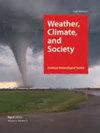人口和地点变量对个性化龙卷风风险区的影响
IF 1.9
4区 地球科学
Q3 ENVIRONMENTAL STUDIES
引用次数: 0
摘要
虽然有明确证据表明,接近龙卷风或预测的龙卷风会增加个人的风险感知,但风险个性化与空间变量之间的具体关系尚不清楚。人们还发现,自己对距离的评估并不总是与客观测量相匹配。这项研究试图解释个人对龙卷风风险的个性化距离在个人相关地理空间因素中的差异,如经常光顾的地方(如家庭和工作)之间的距离、该地区的城市/农村分类以及在该县的居住时间。一项针对八个州(AL、AR、GA、KY、LA、MS、MO和TN)的1023名受访者的调查用于获得风险个性化距离,它们被区分为“担忧距离”(一个人会担心自己的房子或亲人,或采取保护行动的距离)和“确认距离”(人们期望看到、听到或感受龙卷风影响的距离)。我们发现,距离更远的人更频繁地去杂货店和另一个地方,那些将自己的地区定义为城市的人,以及那些拥有高级学位的人,他们的风险个性化距离增加了。在该县居住时间的延长也影响了这些距离。未来的研究需要更好地理解龙卷风发生时地点、风险感知和地理流动性与保护行动的关系。本文章由计算机程序翻译,如有差异,请以英文原文为准。
The Influence of Demographic and Place Variables on Personalized Tornado Risk Area
While there is clear evidence that proximity to a tornado or forecasted tornado increases an individual’s risk perception, the specific relationships between risk personalization and spatial variables are unclear. It has also been established that one’s own evaluation of distance does not always match objective measurement. This study sought to explain the differences in the distance at which an individual would personalize the risk from a tornado across personally relevant geospatial factors such as the distance between places frequented (e.g., home and work), urban/rural classification of the area, and the length of residence in the county.
A survey of 1023 respondents across eight states (AL, AR, GA, KY, LA, MS, MO, and TN) was used to obtain risk personalization distances, which were distinguished as “worry distances” (the distances at which one would worry about their house or loved ones, or take protective action) and “confirmation distances” (the distances at which one would expect to see, hear or feel the effects of a tornado). We found that individuals who traveled greater distances traveled more frequently to the grocery and another location, those who self-defined their area as urban, and those with advanced degrees had increased risk personalization distances. Lengthier residency in the county influenced these distances as well. Future research is required to better comprehend the relationship of place, risk perception, and geographic mobility on protective action when a tornado occurs.
求助全文
通过发布文献求助,成功后即可免费获取论文全文。
去求助
来源期刊

Weather Climate and Society
METEOROLOGY & ATMOSPHERIC SCIENCES-
CiteScore
3.40
自引率
13.60%
发文量
95
审稿时长
>12 weeks
期刊介绍:
Weather, Climate, and Society (WCAS) publishes research that encompasses economics, policy analysis, political science, history, and institutional, social, and behavioral scholarship relating to weather and climate, including climate change. Contributions must include original social science research, evidence-based analysis, and relevance to the interactions of weather and climate with society.
 求助内容:
求助内容: 应助结果提醒方式:
应助结果提醒方式:


